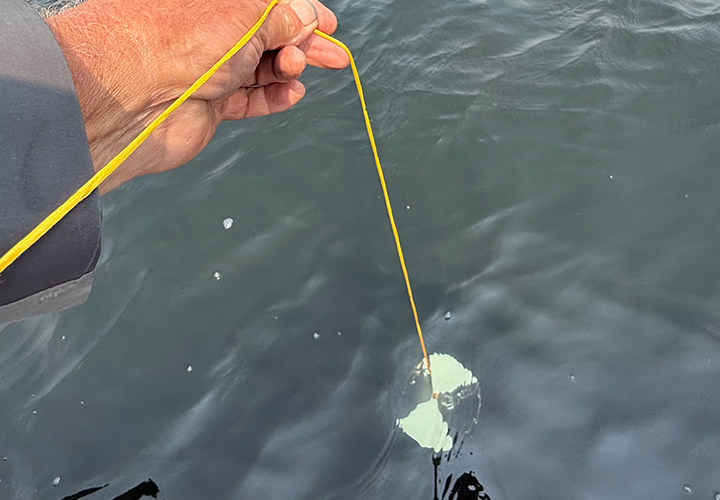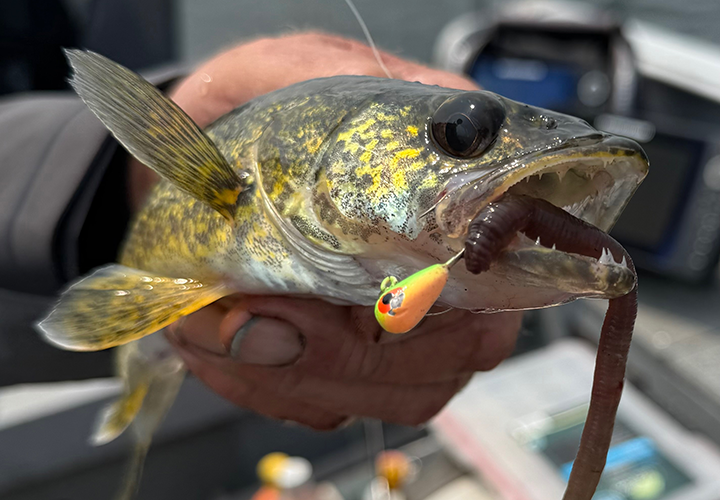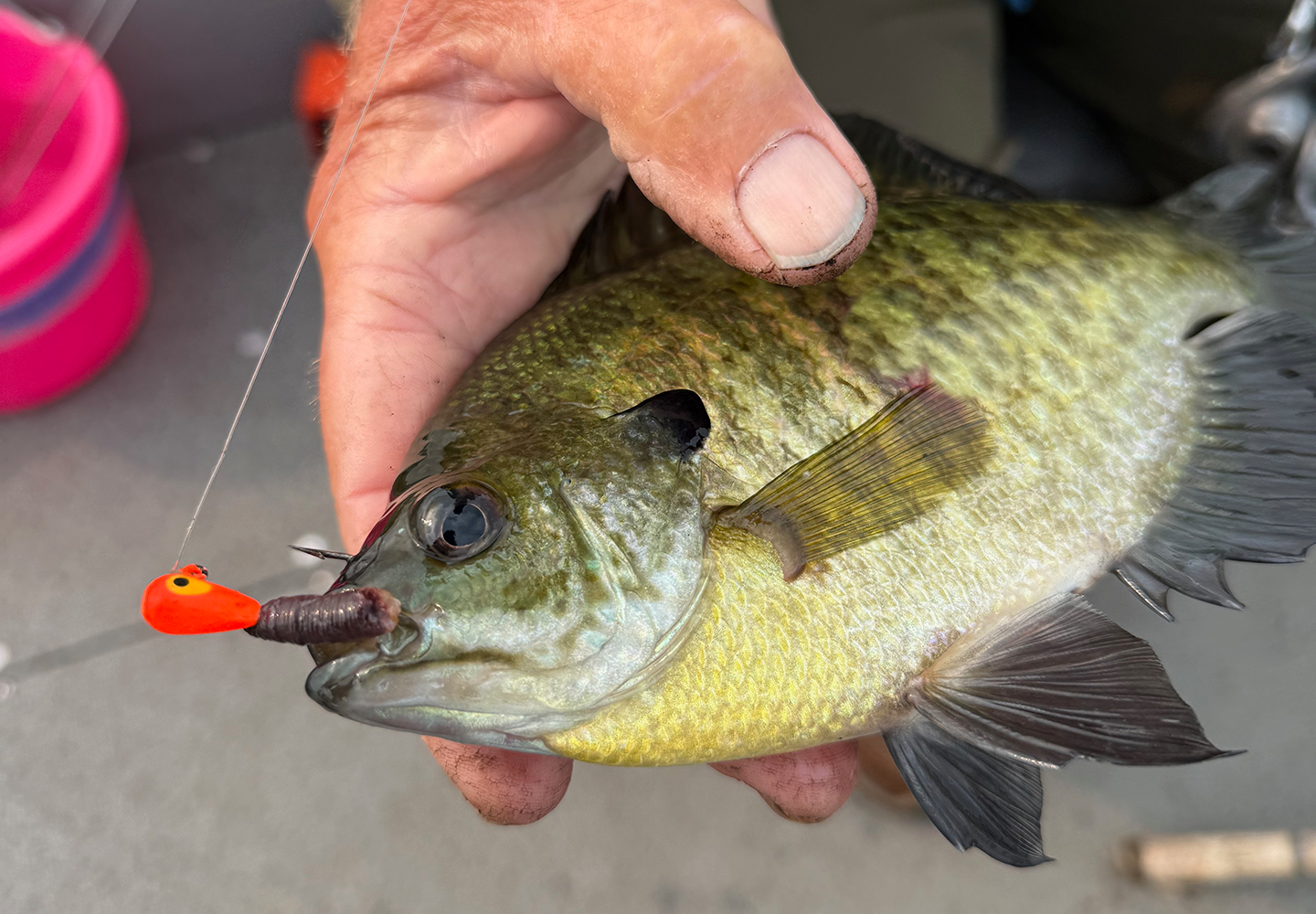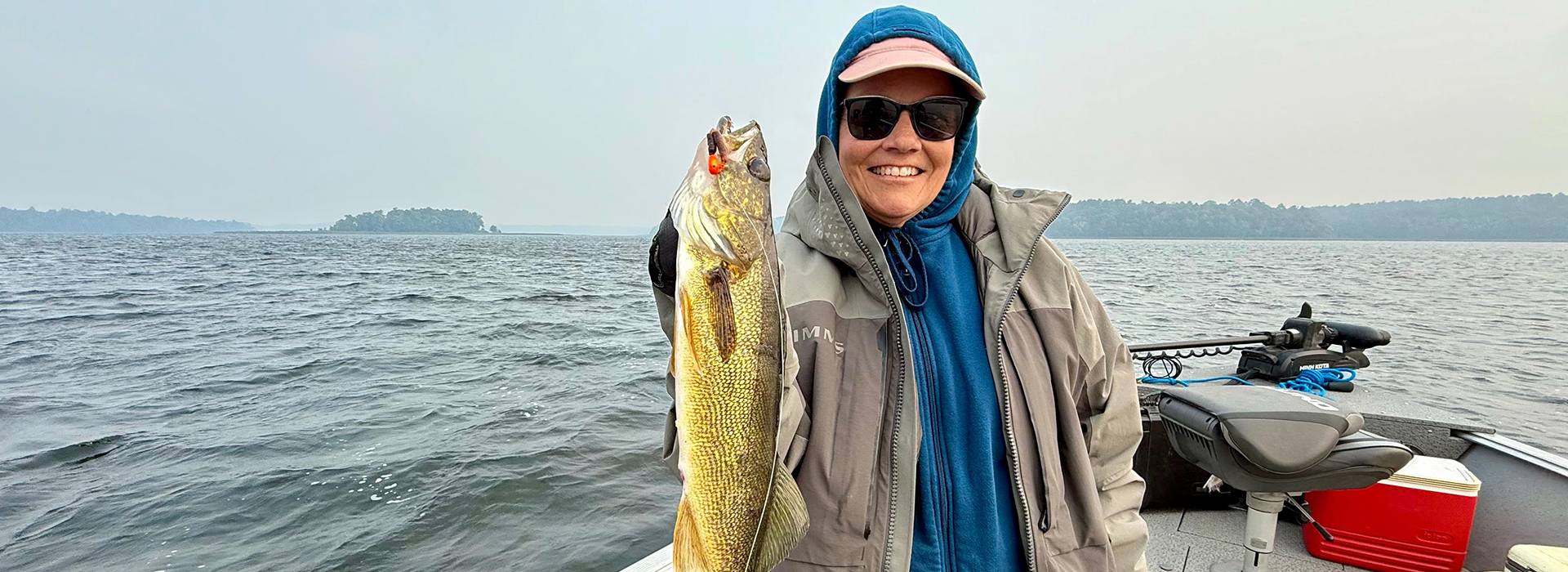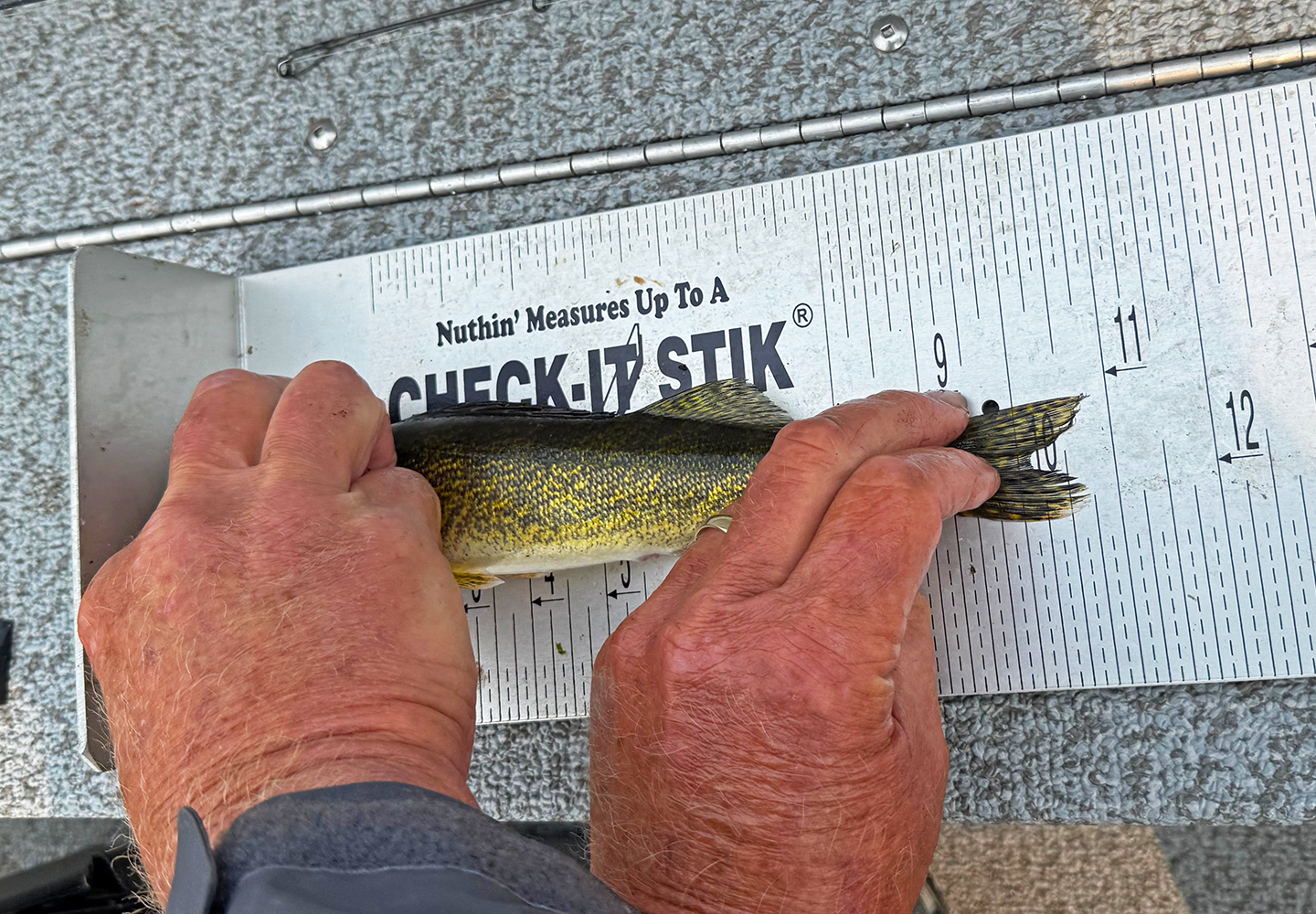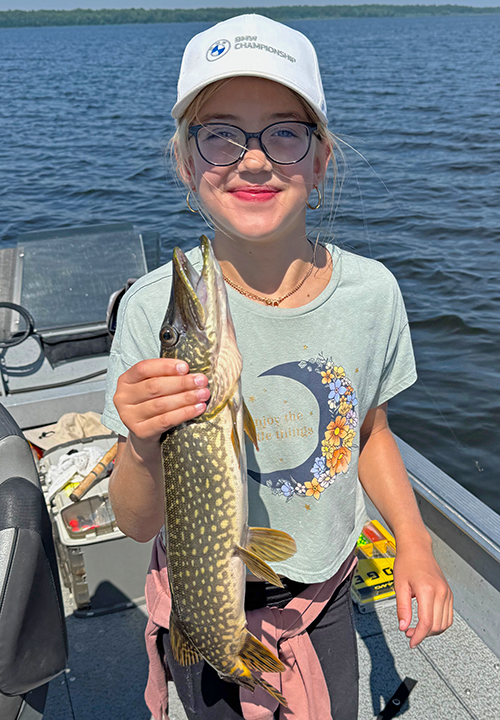The scene was quiet at the marina this Saturday morning in preparation for our guest roster to change over to a new week. But even as we hustled to facilitate “change over day”, friends of the Bowen Lodge family were out on the lake, checking the fishing conditions for our upcoming week.
“Changeover Day” Bowen Lodge Marina Saturday July 13, 2025
First off, a moderate west wind brought in both cooler temperatures, and another round of hazy conditions caused by forest fires burning in west central Canada. The darkened sky, combined with a light-to-moderate algae bloom in the water, helped spur fish activity in both Lake Winnie and Cutfoot Sioux.
Secchi Disk Reading 10 Feet Deep, Cutfoot Sioux Saturday July 13, 2025
Surface temperatures have been on the rise this week and were hovering around 75 degrees on Saturday morning. Caused both by warm and sunny temperatures, and an increased water flow because of the recent rainfall, the added warmth has brought on some additional algae blooms. The Secchi disk reading in Cutfoot Sioux was 10 feet deep on Saturday morning. Still clear by historic standards, but far better (for fishing) than the 18-to-20-foot readings we saw early this summer. The added turbidity makes less wary and somewhat easier for anglers to approach and catch.
Vegetation, especially in Cutfoot Sioux continues to mature. Fish holding plant varieties like cabbage, coontail and flat stemmed pondweed are green, lush and growing deep. Anglers with a long history of fishing Cutfoot Sioux will recall the days when finding a cabbage bed deeper than 8 feet was a chore.
These days, we see plant life flourishing in water depths down to 14 feet of water, even deeper in some regions of the lakes. Wild rice beds now stand tall above the surface, and bulrush patches are green and mature too. The heavy vegetation isn’t always loved by anglers, but it is loved by gamefish. So, embracing fishing presentations that target the thick vegetation will pay off from now, on into the early fall.
Wiggle Worming For Walleyes on Cutfoot Sioux
Last week we reported that some of the popular trolling presentations were coming to their peak of effectiveness. Fishing with spinners tipped with live bait produced mixed bags of walleye, pike, perch, rock bass and sunfish. On Saturday, trolling spinners tipped with night crawlers were used to search for fish, but once located, wiggle worming was the preferred presentation used to drill into the habitat and catch both walleyes and sunfish; here’s why.
Sunfish, especially when water temperatures are warm, will strike spinners readily. But because of their nature, bluegills typically gather tightly, in compact schools adjacent to their preferred feeding structures. So, once it’s located, it’s a good idea to stop trolling, slow down, and use live bait jigs tipped with worms, leeches or cut pieces of night crawlers to catch them.
Wiggle Worming produces walleyes, but quality sunfish love the presentation too.
Walleyes during mid-summer often find small spots of hard bottom structure within stands of vegetation. While trolling presentations still work, they become less efficient because the spinners are only in the fish’s strike zone for a short time. Targeting the isolated, and sometimes small “hard spots” with slower moving, more methodical presentations is more efficient. So, on small spots located adjacent to or within the cabbage patches, slowing down and using live bait approaches like wiggle worming is a great idea for walleyes.
Combine walleyes, with sunfish and you have a great opportunity for mixed-bag catches. And if you like, presentations like slip-bobbers, vertical jigging and casting small jigs tipped with plastics will also produce fish using these, and similar structures.
Wiggle Worming walleye on Cutfoot Sioux July 12, 2025
If you’re not familiar with the wiggle worming presentation, you should be. Instead of using valuable time to go through the details here, we’ll suggest that you follow this link to a resource that walks you through the presentation in full detail. Read article “Wiggle Worming 101”.
On the big lake, trolling presentations remain effective too. In last week’s report, we offered tips about fishing with spinners both on the flats, and over the tops of cabbage patches. The guidance hasn’t changed, and it’s a good idea to review the previous report for a refresher course. Follow this link to the >> Bowen Lodge Fishing Report July 3, 2025.
Mid-lake structures continue to be popular spots for locating and catching walleyes during mid-summer too. We hear from local guides and some of the better walleye anglers who stay here seasonally, that they continue catching fish on these structures. Because many of the spots have been targeted repeatedly, many of the “keeper” size walleyes have been strained off, and that the proportion of fish in the “protected slot” is rising. So, carefully releasing these fish, especially now when the water is warm, is important.
Numerous small walleyes caught in Cutfoot Sioux and Lake Winnie: An indication of good 2023 year class?
The size structure of 2019 Lake Winnie walleyes, as we reported in our 2025 Lake Winnie and Cutfoot Sioux Season Outlook, has shifted heavily into the protected, 18-to-23-inch protected slot. Late last summer, guests and friends were fishing the big lake reported catching good numbers of small, 9-to-10-inch size walleyes. Again, this summer, we are beginning to see decent numbers of these small fish turning up in both Winnibigoshish and Cutfoot Sioux.
This fish, measuring almost 11 inches, is like from the class of 2023 and offers a sneak preview into what may be another good year of up-and-coming walleyes. As we enter the summer lake survey testing season, we’ll get frequent updates from the DNR Fisheries staff and will keep you in the loop as new discoveries are reported.
Perch fishing has been spotty for our guests. The better size perch, 10 to 11 inches, are available but show up in random locations, and appear to be nomadic. Our best advice is to use your opportunity when it comes along. If you’re fishing an area, and begin catching some keepers, drop whatever you were doing and focus on perch for the moment. Often, returning to the same area at a different time, or when conditions change, will be disappointing.
It is not disappointing that there appears to be a lot of young yellow perch in the system right now. As these small fish mature, we will enjoy better fishing for quality size perch. We’ll make a point of getting an update about perch populations, and growth rates for an upcoming report.
Crappies typically become easier to catch using trolling presentations during late summer. So far, few of them have been reported, and do not appear to be present in large numbers. Appearances can be deceiving though, and there could be lots of fish hiding in some of the dense patches of cabbage. As always, we advise you to search for crappies during the lowlight periods during early morning and late evening. Crappies often reserve their feeding spurts to these crepuscular periods and can be very easy to catch when they want to be.
We see an increase in activity among northern pike anglers recently. There are more folks casting large lures over the vegetation, on the rocks and along the steep, mid-lake breaklines. While catching numbers of eater size pike, below the 22-inch threshold using the popular trolling presentations is effective, casting large lures will produce more large fish.
Large pike can be particular at times, and often one presentation will outperform another. Large spinnerbaits, in-line bucktail spinners, jerkbaits and large plastic swim baits can all be productive. Experiment with each, and change as fish feeding preferences vary. During high, sunny skies, use large, lively minnows suspended below slip-floats for better action. On cloudy, or drizzly days, pike will move high above the vegetation, and shallow running lures will become more effective.
Last week, we announced that the Minnesota DNR Fisheries Chief, Brad Parsons plans to go forward with a statewide walleye possession limit reduction. Presently set at 6 walleyes, the new limit, if enacted, would allow our guests and visiting anglers to return home with 4 walleyes instead.
August 15, 2025, is the deadline for all of us to participate in the online survey, click the image or follow this link to the >> Minnesota DNR Fisheries Walleye Bag Limit Reduction Proposal Survey. Regardless of your point of view, be sincere and let the DNR know what it is. This is the only way that they can make the best decision; one which will affect all of us who fish for walleyes, long into the future.


